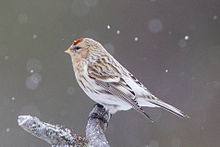Arctic redpoll
| Arctic redpoll | |
|---|---|

| |
| Scientific classification | |
| Domain: | Eukaryota |
| Kingdom: | Animalia |
| Phylum: | Chordata |
| Class: | Aves |
| Order: | Passeriformes |
| Family: | Fringillidae |
| Subfamily: | Carduelinae |
| Genus: | Acanthis |
| Species: | A. hornemanni
|
| Binomial name | |
| Acanthis hornemanni (Holbøll, 1843)
| |
| Synonyms | |
| |

The Arctic redpoll or hoary redpoll[1] (Acanthis hornemanni) is a bird species in the finch family Fringillidae. It breeds in tundra birch forest. It has two subspecies, A. h. hornemanni (Greenland or Hornemann's Arctic redpoll) of Greenland and neighbouring parts of Canada, and A. h. exilipes (Coues' Arctic redpoll), which breeds in the tundra of northern North America and the Palearctic. Many birds remain in the far north; some birds migrate short distances south in winter, sometimes travelling with common redpolls.[2]
The genus name Acanthis is from the Ancient Greek akanthis, a name for a small now-unidentifiable bird, and hornemanni commemorates the Danish botanist Jens Wilken Hornemann.[3] The name "arctic redpoll" is used in Europe and "hoary redpoll" in North America.
As of 2024, the American Ornithologists’ Union (AOU) lists it, the common redpoll, and the lesser redpoll as the same species (Acanthis flammea).[4]
Description
[edit]The Arctic redpoll is similar in appearance to the common redpoll but generally paler. It may be distinguished from that species by the unstreaked pale rump patch and the uniformly pale vent area. The Greenland race is a very large, pale bird, with the male sometimes described as a "snowball", but both forms are pale with small beaks, white rumps and often more yellow than grey-brown tones in their plumage. They have black bibs, orangish forehead patches and two light-coloured stripes on each wing. The females are more streaked on their breasts, sides and rumps, but are still pale. Adults are about 12 to 14 centimetres (4.7 to 5.5 in) in length and weigh about 12 to 16 grams (0.42 to 0.56 oz).[5] Wingspan ranges from 20 to 25 cm.[6]
Behaviour
[edit]The Arctic redpoll is partially migratory and tends to move southwards in November and north again in March and April. It feeds mainly on seeds, particularly of alder and birch trees.[5]
Breeding takes place from May to July. The nest is built low down in a tree or bush and is neatly built with an outer layer of twigs, a middle layer of root fibres, fragments of juniper bark and lichens and an inner layer of down, willow buds and reindeer hair. Three to seven pale blue eggs with light reddish speckling are laid and incubated by the female. They hatch after about eleven days and the young fledge in about a further thirteen days.[5]
Taxonomy
[edit]Due to its similarity to other redpolls, the Arctic redpoll has been under consideration for combining with the other species on the AOU checklist since 2017.[7] Genetic evidence found in 2021[8] was considered sufficient to combine the redpolls into a single species.[9]
References
[edit]- ^ a b "Acanthis hornemanni". NatureServe Explorer An online encyclopedia of life. 7.1. NatureServe. Retrieved 13 December 2022.
- ^ "Hoary Redpoll: Life History". Cornell Lab of Ornithology. Retrieved 2 November 2020.
- ^ Jobling, James A. (2010). The Helm Dictionary of Scientific Bird Names. London, United Kingdom: Christopher Helm. pp. 29, 195. ISBN 978-1-4081-2501-4.
- ^ Chesser, R Terry; Billerman, Shawn M; Burns, Kevin J; Cicero, Carla; Dunn, Jon L; Hernández-Baños, Blanca E; Jiménez, Rosa Alicia; Johnson, Oscar; Kratter, Andrew W; Mason, Nicholas A; Rasmussen, Pamela C; Remsen, J V (1 July 2024). "Sixty-fifth Supplement to the American Ornithological Society's Check-list of North American Birds". Ornithology. 141 (3). doi:10.1093/ornithology/ukae019. ISSN 0004-8038.
- ^ a b c "Arctic Redpoll: Carduelis hornemanni". NatureGate. Retrieved 13 December 2013.
- ^ Oiseaux.net. "Sizerin blanchâtre - Acanthis hornemanni - Arctic Redpoll". www.oiseaux.net. Retrieved 29 September 2020.
- ^ Kaufman, Kenn (7 August 2024). "Lumping Redpolls and Splitting Seabirds: This Year's Updates to North American Bird Names". Audubon. Retrieved 25 September 2024.
- ^ Funk, Erik R.; Mason, Nicholas A.; Pálsson, Snæbjörn; Albrecht, Tomáš; Johnson, Jeff A.; Taylor, Scott A. (25 November 2021). "A supergene underlies linked variation in color and morphology in a Holarctic songbird". Nature Communications. 12 (1). doi:10.1038/s41467-021-27173-z. ISSN 2041-1723. PMC 8616904. PMID 34824228.
{{cite journal}}: CS1 maint: PMC format (link) - ^ Ye, Yvaine (18 July 2024). "The redpoll finch saga: How two bird species just became one". CU Boulder Today. Retrieved 25 September 2024.
External links
[edit]- Oiseaux.net Photos, text, map
- "Arctic redpoll media". Internet Bird Collection.
- Hoary redpoll photo gallery at VIREO (Drexel University)
- Hoary Redpoll Species Account – Cornell Lab of Ornithology

